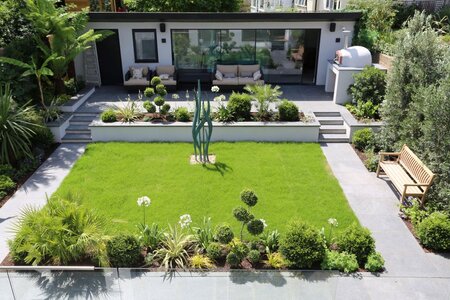Graduate wins competition to re-design historic Chapel Court garden at Hampton Court Palace
Garden Design Diploma graduates were recently invited to respond to an exciting brief from Historic Royal Palaces, which included redesigning the Chapel Court Planting Plan at Hampton Court Palace, with work scheduled to start later this year.
The brief
Graduates were asked to consider the following:
- Plants have to be able to deal with the harsh conditions inside the Court
- Planting has to look good for extended periods of time
- The concept should come with well researched choices of plants so that these may be made into educational boards for visitors in the future
- It must work within the historical context
The project
The garden in Chapel Court was created to mark the 500th anniversary of Henry VIII's accession to the throne, and evokes his court and the story of his reign.
The basis for the new scheme is the garden depicted in The Family of Henry VIII (c1545), which hangs in the Haunted Gallery. This portrait shows a contemporary garden at Whitehall Palace, bristling with 'Kyngs beestes' perched upon lofty painted posts. The beasts are set in a garden criss-crossed by green and white painted post and rail fencing, encompassing beds sprinkled with herbs and flowers.
The planting incorporates alternating displays of herbs and flower varieties, which were available in England in the 16th century. The designs of the new beasts are based upon drawings produced in the early 16th century, now in the College of Arms, and their bright livery reflects the traditional Tudor heraldic colour schemes. Each beast is carved in English oak and has a special significance in the iconography of Henry VIII.
The winning concept
2023 Graduate Jonny Lincoln’s beautifully produced and historically relevant concept for Chapel Court, ‘Patterns of the Past’, won the competition.
The concept takes inspiration from Tudor knot gardens, Hampton Court’s historic brickwork and Gerard’s Herbal (1597) source book of plants in the British isles during the reign of Henry VIII.
- A traditional knot garden is formal in structure with practical yet ornamental planting often seen as an extension of the kitchen garden. The challenging shade conditions provide an opportunity to reinterpret the traditional knot garden, with the planting becoming more naturalistic and relaxed towards the north and west facing elevations.
- The eight beds recognise the practical uses of plants cultivated in the Tudor period as well as meanings attributed to them within Gerard’s Herbal around the themes of: magic, aromatic, culinary, romantic, medicinal, domestic, woodland and artistic. As plants tend to have more than one function, they are often used across multiple beds which brings cohesion to the scheme as a whole.
- The long-term plantings provide seasonal interest and multi-sensory enjoyment, presenting a living history that acts as an educational tool to visitors on Tudor plants and their many uses. Self-sown annuals of Centaurea cyanus, Nigella damascena ‘Miss Jekyll’, Papaver rhoeas and Silene dioica can be weaved through the hardy perennials with autumn sowings, introducing another degree of dynamism and a connection to the surrounding ‘flowery mead’.
- For added sustainability and ease of maintenance, perennials can be divided for use across various beds, and the low growing form of Yew (Taxus x media ‘Hicksii’) is easily clipped to create a robust evergreen framework without running the same risk of pests and disease as the traditionally used Buxus sempervirens.













